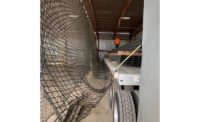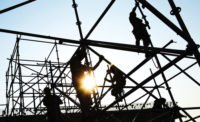Fall equipment for Nik Wallenda’s Niagara Falls act

EFSS, Wilmington Del., was selected in an overview role to check the structural engineering of the cable that the Wallenda Group had invested in. It was designed by an engineering company resulting in a two-inch diameter cable, far broader than Nik’s usual tightrope walking using 5/8-inch diameter lines.
Safety first?
The universal opinion from the Wallenda Group was that Nik did not need a harness system. The frequent quotation was, “If we do the walk right the first time, then there is no need for safety or any backup” The underlying thought was that there was the possibility that the safety equipment itself may prove to be hazardous and cause an accident such as tripping.
There was no thinking by the Wallenda Group about errors, misjudgments, unforeseen conditions. The possibility of failure and probable death was not on the radar. And less than two months later in August, Nik was to walk above the boardwalk of Atlantic City next to the Tropicana Casino and Resort. On that occasion the cable was guyed every few feet to reduce vibration, but no safety system was used.
Sponsors speak out
However the walk sponsors viewed the televised event as a family show and less as a Roman spectacle. A harness system had to be chosen and fortunately Nik had familiarity with a mountaineering seat harness which he owned and demonstrated when wearing it.
However the nose to toes fall orientation with a back loop attachment had to be avoided in our opinion. Nik would not consider the paired shoulder harness companion to the seat harness. He agreed to a front attachment and guiding the lanyard around the body from the front attachment to roughly the center of the back seat harness waist strap held in place with a strip of Velcro and two plastic zip ties.
Accepting a degree of safety
The process of acceptance of a fall protection system began with a discussion of the seat harness, then the sliding anchor and finally the lanyard and keeping these components out of Nik’s way, so they would not be distracting. It continued with an analysis of the components into a system which was reasonably trustworthy although we had insufficient time to test the system dynamically. This became known as the trailing tether system. Responsibility for the sliding anchor (traveler) on the 2-inch diameter cable was accepted by Nik’s uncle, Mike Troffer, a former naval engineer.
Rescue capabilities
In the Niagara Falls crossing, the cable design firm was instrumental in reducing cable vibration and movement by hanging weighted pendulums approximately every 100-150 feet to dampen the vibration in the cable. The cable span was approximately 2,000 feet between crane hooks and held by grouted anchors drilled into the bedrock on either side of the border. Load testing of the anchors was witnessed by our structural engineer. The tension in the cable was checked periodically during the walk after re-tightening up to 60,000 lbs.
The length of the cable was checked by linemen on the day prior to the walk for any burrs by riding an emergency access rescue system, but none were found. The actual rescue system consisted of two transmission tower cable span wire cages, one each side, and was readied for access by local firefighters from an elevated aerial lift on both American and Canadian sides to reach any point on the cable if necessary during an emergency. The cages were to be deployed by gravity to the lowest point on the cable and retrieved by a winch on each side as needed
55 mph winds
The ultimate price of danger walking a tightrope is death, although it is not known exactly how survivable a plunge into the Niagara River would have been. Walking a tightrope across the Falls through waterfall‐caused winds, 55 mph according to Nik, blowing in all directions plus heavy mist from the 175-foot water fall height and pounding certainly would be classified as a danger by anyone — except possibly the risk‐taker himself, a seventh generation wire walker.
Selection of the equipment
The lanyard is the connection between harness and sliding anchor. The lanyard needed to be guided around the waist and temporarily secured to a rear harness location with plastic zip ties which would break loose in a fall. The result would be a sitting position for Nik in the seat harness post-fall waiting for rescue.
Anchor points in industry and construction are almost always recommended to be positioned at above harness shoulder D‐ring height. In the case of Nik, the anchor point had to be the cable he was walking on, namely underfoot.
Possible nine-foot free fall
Thus the fall distance would exceed twice the distance from the harness back D‐ring to the cable five feet plus a distance where the traveler would position itself clear of the ankles as Nik was stepping. However Nik chose to wear only a seat harness without a shoulder harness. The final lanyard length was measured from Nik walking on a low level cable, and many scenarios were tried to see if the traveler could be made to stick or jam at the pendulums. Fortunately it did not, and we set the lanyard length to be 41.5 inches from his 40-inch high waistline back attachment. This lanyard length would make Nik’s free fall approximately 9 feet into open space. His weight was 185 lbs and the capacity would be 1665 lb ft. The additional 40 ft/40 lbs balancing pole was not included in the calculations because Nik intended to dispose of it after falling onto the wire, an opinion shared by his team.
Once up the scissor lift and onto the launch scaffold platform, the other end of the wire cable was attached to the traveler with a carabiner and then to a shackle and the carabiner fixed from rotating with a plastic zip tie. The attachments were observed one more time before the signal to leave was given. Nik was then up and on his way; 27 minutes later, Nik stepped from the cable onto the scaffold platform on the Canadian side.
Looking for a reprint of this article?
From high-res PDFs to custom plaques, order your copy today!







